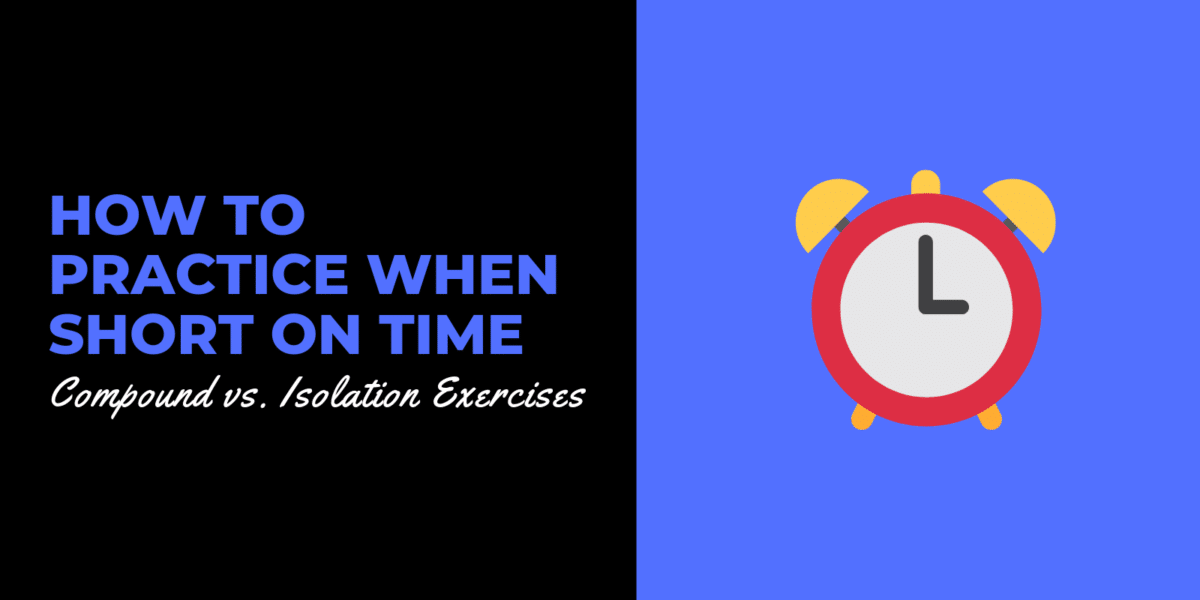It’s a common pain for every drummer. You’ve practiced the same drum lick over a thousand times at all tempos. You swear you could do it in your sleep. But when it comes time to bust it out on stage at your sweet coverband gig, you completely blow it.
Considering the amount of time that went into practicing that damn lick, you are left wondering what went wrong. So what happened?
Archilochus put is best when he said, “we don’t rise to the level of our expectations, we fall to the level of our training”. And as I’ve already mentioned: drum skill = time spent in practice. But sometimes, no matter how many times we run through drum licks or patterns, they never show up in a live context.
Drumming Integration
In most cases, the missing link between practice and performance is what I call drumming integration – the act of absorbing the drum material you practice so deep into your muscle memory that it becomes a part of your everyday playing. Naturally, integrating what you practice is easier said than done.
At first glance, when asked how to integrate a drum pattern, our first reaction would be to practice. This is certainly correct, but it doesn’t give us a complete picture of HOW to do it. We know we need time and repetition to learn something, however if you don’t know what to aim for, you’ll end up wasting a lot of that time.
To help paint a better picture, let’s look at something everyone understands: language.
Si señor
Have you ever spent months learning a language on the computer only to find yourself panicked and stuttering when trying to converse with a native speaker in real life? As frustrating as this is, it happens to me all the time.
I have tried to learn Spanish a number of times. I’ll be flying through the questions on Duolingo and getting things near perfect. But when encountering a native Spanish speaker, I am embarrassingly bad.
There are a lot of reasons for this, lack of confidence, different accents, lack of practice, but all the reasons basically boil down to the fact that I have not completely integrated the basics of Spanish into my vocabulary.
“The Carrot is Purple”
If we go back to English, we can learn how to integrate language a little better by taking a word we all know very well and dissecting it. Let’s try the word “carrot”.
At first glance, carrot is a pretty simple word, but let’s do a little analysis and find out what we really know about the word:
A carrot is a root vegetable. It has a number of vitamins and minerals that make it healthy. It grows from the ground and contains a leafy top. It is usually orange in color, crunchy in texture, and ranges in taste from sweet to bitter.
The word “carrot” contains six letters and two syllables. It has a harsh K sound at the beginning and ends with a quick T sound. It kind of sounds like two separate words, “care” and “rot”, put together.
Soon you find out that carrots also come in vary colors like red and purple, and that they range hugely in size and flavors. Not to mention the amount of varying species, types, and foods that would be considered cousins or relatives.
How about all the ways you can cook a carrot? How about all the ways you can say carrot?
You probably have never really thought about a carrot this way, but that’s because the word has been built into us since childhood. Internally, we already know all of these things about carrots because they were integrated into our being at an early age. But hopefully this has painted a picture of what it takes to integrate NEW things into our bodies.

Via Giphy
Integration of Drumming Material
At this point it should be getting more clear that the reason the material we practice doesn’t show up when we perform live is because we don’t know the material as well as we thought. Repeating a pattern 10,000 times is the same as saying the word “carrot” 10,000 times – After a while, it loses all meaning.
I’ve developed a three stage method that I personally use to help me take what I practice straight to performance. This method will help you to know what you’re practicing on a deeper level and engrain it inside your muscle memory. It also has the added benefit of being a fun way to practice.
In order to work on each stage, we’ll need something to practice. As an example, let’s take a rudiment everyone knows and loves and give it the ol’ 1-2-3: The Single Paradiddle.
Let’s begin.
Stage 1: Technically Correct
The first stage to drumming integration is playing things technically correct. It is the stage that most would consider “practicing”, since it’s literally just repeating what’s on the page. Unfortunately, this is also the stage that most drummer’s stop at. Considering that playing things technically correct is only 1/3 of integration, it makes sense that there would be trouble performing down the road if we stopped here.
But before we get ahead of ourselves, let’s begin with stage one and learn how to correctly play a paradiddle:

We know that a paradiddle is a rudiment, which are traditionally played on the snare drum. So practicing on the snare is a good starting point.
From the looks of it, we can also see that the paradiddle is a sticking pattern (Series of rights and lefts). There are eight notes in total that are all played equidistantly as 16th notes. The last thing to notice is that there are two accents evenly placed at the beginning and in the middle after 4 notes.
Now that we’ve looked it over, let’s play it. Overall, the single paradiddle is a simple rudiment to play. As long as the notes are evenly spaced apart, it’s just a matter of wrapping your head around the sticking pattern. Once the pattern is down, the next challenge is adding the accents and getting them to pop.
After some time, you should feel pretty confident about the paradiddle. Next, you’ll want to attempt it at varying tempos to know your technical limits when playing it.
Once you’ve practiced the paradiddle to the point of being able to play it at both slow and fast tempos while maintaining a strong accent, you will have completed stage one. Basically, all you needed to do was get the rudiment under your fingers. This applies to everything you are trying to practice, be it grooves, patterns, licks, or entire songs.
If you were to stop at this point, your memory of the paradiddle would eventually fade and you would have trouble pulling it out in a live pressure situation. Oddly enough, this is when most people will move onto the next exercise. But, there is a lot more to go before the single paradiddle becomes a part of you, so let’s move onto stage 2.
Stage 2: Exhaust the Possibilities
Now that we’ve learned how to play the single paradiddle technically correct, it’s time to move onto stage two and explore every way we can apply the rudiment. Stage two is the mat of integration practice and is the most time consuming. It’s only limits are your imagination and technical capabilities.
In short, in stage two you want to take whatever you are working on and put it through as many different scenarios as you can think of.
To avoid fatigue and overwhelm, it’s important to set the rules of how you are going to practice the scenario beforehand and stick with them. I find most drummers will come up with some common ways of applying patterns and rudiments that work for them and repeat them for most things they practice.
Let’s see how we can mess around with the single paradiddle.
Move it Around the Kit
A good starting point and one of the simplest approaches to learning a new pattern is to move it around the kit. If we were playing a drum beat, you could start moving between the hi hat and ride cymbal, or replacing the snare drum with a rack tom. But what can we do with the paradiddle?
First off, we could move the paradiddle from the snare drum and try it on different drums and cymbals. After that, we could split up the hands and place them on different drums. For example, we can assign any R’s to the floor tom, and any L’s to the rack tom. As you can see, these two steps are already pretty exhaustive, but we’re just getting started.
Don’t forget that you can use your feet as well, so be sure to try out a paradiddle between your kick and hi hat, or on a double pedal.
Add Accents and Articulations

If you are more than comfortable moving the paradiddle around the drums, you can start to mess with the accents. Try adding or subtracting different accent patterns to the paradiddle. Have you ever played a paradiddle with the accents on the “e”, or the “a”? It’s quite challenging and yields some cool results.
For changing accents I created a very simple grid that I follow. It’s one of my most common practice tools, and you can check it out here.
If you’ve been moving the accents around on the snare drum only, next is your chance to try these accent patterns around the kit as well. Don’t forget your feet!
You can also try other articulations, but for some patterns like the paradiddle, it might not make sense. For example, unless you are an advanced player, thinking about the difference between staccato and legato notes while playing a paradiddle on a snare may only turn into a massive headache. However, for some of you, this can open up a lot of new creative avenues.
Alter the Rhythm and Phrasing

By this point, we’re already getting to know the paradiddle quite well. You might have already discovered plenty of new use cases that you’re trying as we speak. But there is always more to experiment with, and one of my favorites is changing the rhythm and phrasing.
At the moment, we’ve been playing the paradiddle as steady, equally spaced 16th notes. But what happens if we try the same pattern as triplets? quintuplets? A combination of both?
Some of the examples might start getting weird, but that’s alright. Practice is supposed to be messy.
As another example, you could try playing a paradiddle in ascending and descending rhythms of the note tree, or move it into different time signatures to see how things line up. There is no limit to how rhythms can be worked with, so I would suggest picking a few ideas that sound cool and sticking with those. You can always try more later.
Once you’ve explored a few different rhythms, you can now layer them on top of some accent patterns and can move it around the kit. Don’t forget your feet!
Add Dynamics

Similar to accents and articulation is adding dynamics. This is the icing on your practice cake and is what separates the amateurs from the professionals. Being able to take all of the concepts above and apply control in the form of volume is going to be a challenge.
Dynamics also cover their own broad range from super soft all the way to ear splittingly loud. You can try each method at it’s own dynamic, or you can combine them by adding crescendo’s and decrescendo’s. Again, the only limit here is what you can come up with.
Stage 3: Improvisation
By now, you’ve taken the single paradiddle farther than most drummers ever have or ever will. You have also earned a familiarity with the rudiment that will start to pay dividends in all your future playing. Considering it’s versatility, working this hard on the paradiddle is time well spent.
But we aren’t done yet.
In order to fully assimilate the paradiddle into a your vocabulary, we need to get to the final stage of drumming integration, which is improvisation. Step one was all about playing the rudiment correctly, then step two was exploring every which way that rudiment can be played. Now stage three is all about thinking ahead of yourself and learning how to organically manifest what you’ve been practicing in a live context.
For those of you that have never practiced improv, it’s easier than you think. Just make up stuff as you go. The challenge lies in thinking ahead and drawing from what you’ve already been working on. When you run into a wall, take a moment to step back and think about the different things you’ve been practicing, then try again.
Improv and creativity can be practiced in a few ways. One is free form. Without rhythm or time, try freely playing paradiddles around the kit with different accents as fast or slow as you like. Or bring back the time and phrasing, but try increasing and decreasing your volume at will. There are few rules to free form improv, just as long as you’re still playing a paradiddle (In some form of another).
A second way to practice creativity is with a more rigid approach. Try the paradiddle as fills between beats, or trade with yourself between a grooves. For example, I frequently practice trading 4’s between myself. I will play 4 bars of a beat in any given style and then practice improvising whatever exercise I’ve been working on for the next 4 bars.
This sort of trading is perfect if you have another drumming friend to work with. Nothing is more inspiring that trying to steal licks and ideas from one another.
After some time, you will start to see what appears to be sticking and what you’re forgetting about. If you happened to be working on something that you thought was really cool that you want to start showing up in your playing, go back and try to add it into your improv sessions.
Practicing creativity has no definite end, but the more time you dedicate to it, the easier being creative becomes in the moment. Ideas will flow better and you’ll find accessing previous practice material easier and more immediate.
Putting it all Together
Hopefully you agree that the only reason we have issues with manifesting our practice material in live situations is because our methods need changing. Spending time in the practice room is extremely important, but it’s just as important to have a clearer picture of how we are going to spend that time.
This three stage practice approach should answer a lot of questions and open up plenty of new ideas for how you can approach your material.
Do you agree with my approach? Are there other methods of practice or exploration of an exercise that I forgot to mention? Let me know down below!









Great approach to maximizing practice time. I constantly find myself in a drumming rut and waste hours starring at the kit looking for answers. My new challenge is to use your approach for inspiration, thank you.
Let me know how it goes!